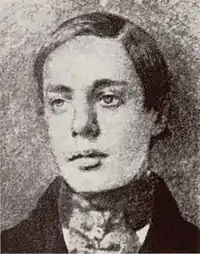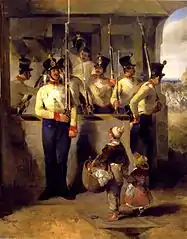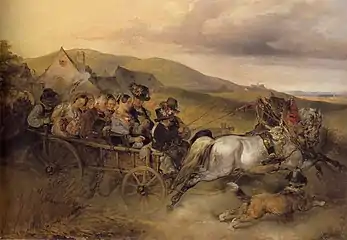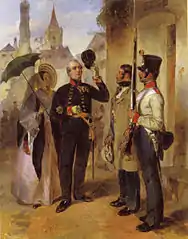Carl Schindler
Carl Vincenz Schindler (23 October 1821 in Vienna – 22 August 1842 in Laab im Walde) was an Austrian military painter in the Biedermeier style. He was sometimes referred to as "Soldaten-Schindler" (Soldier Schindler).

Life
He received his first lessons from his father, the painter and engraver Johann Josef Schindler,[1] who also encouraged his interest in military subjects. In 1836, he enrolled at the Academy of Fine Arts, where he studied with Karl Gsellhofer (1779–1858) and Leopold Kupelwieser. Later, he took private lessons from his father's friend, Peter Fendi.[1] It was Fendi who introduced him to the works of the French military painters, Bellangé, Charlet, Lami and Raffet. In 1839, he had his first exhibition at the Academy.
He was suffering from tuberculosis and his health was fragile, so he had to interrupt his studies several times. He visited Laab im Walde, to try the "water cure", but it was to no avail and he died there at the age of twenty-one.[2]
Rather than portray battle scenes or heroic acts, he preferred to focus on the soldiers' daily lives, creating a link between military art and genre painting.[2] His works influenced Friedrich Treml and August von Pettenkofen.
Selected paintings
 The Sentinel
The Sentinel Foraging Hussars
Foraging Hussars The Wedding Journey
The Wedding Journey The Sentry
The Sentry
References
- Hermann Arthur Lier (1890), "Schindler, Karl", Allgemeine Deutsche Biographie (ADB) (in German), 31, Leipzig: Duncker & Humblot, p. 784
- Entry from the "Biographisches Lexikon des Kaiserthums Oesterreich" @ Wikisource.
Further reading
- Franz Martin Haberditzl, Heinrich Schwarz: Carl Schindler. Sein Leben und sein Werk., Österreichische Staatsdruckerei, Vienna 1930
External links
| Wikimedia Commons has media related to Carl Schindler. |
- S. Kehl-Baierle: "Schindler Carl (Vincenz)". In: Österreichisches Biographisches Lexikon 1815–1950 (ÖBL). Vol. 10, Austrian Academy of Sciences, Vienna 1994, ISBN 3-7001-2186-5, p. 147.
- Two more paintings @ Austria-Forum
- Carl Schindler @ the Niederösterreich Landesmuseum